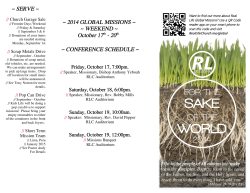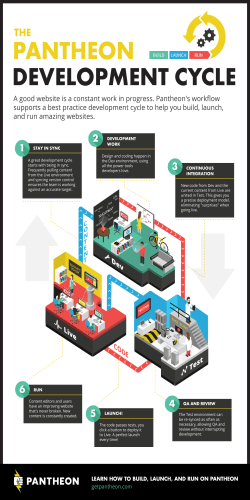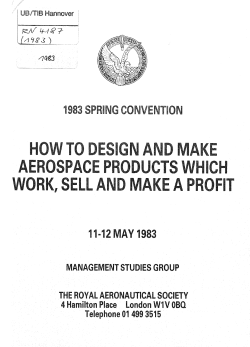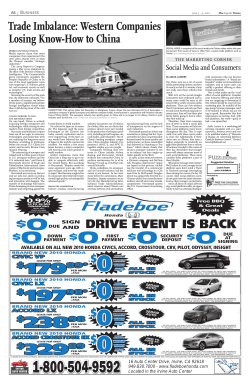
NRC Decadal Survey Implementation Cost And Technical Evaluation (CATE) Steven Battel
NRC Decadal Survey Implementation Cost And Technical Evaluation (CATE) Steven Battel Space Studies Board Astro 2010 Survey Committee Member Heliophysics 2013-2022 Steering Committee Member Top Level View The CATE process was created for the Astro 2010 Decadal Survey based on the requirement to provide an independent cost estimate for missions and projects presented in the survey. Aerospace Corporation was selected to implement the process on Astro 2010 and then subsequently for the Planetary and Heliophysics surveys. The process has evolved for each survey based on lessons learned and the unique requirements placed on each effort. The response of NASA, OMB, OSTP and other Agencies has been positive such that the process is likely to be repeated on future surveys. 2 What CATE IS and IS NOT Is: Based on detailed project input. Application of uniform and historical data-informed risk analysis. Independent appraisal of project budget, schedule and technical risk. Considerate of a wide range of maturity in the concepts with respect to total life cycle, including “pre-Phase A” and designed to be fair and neutral. Projection through the decade considering potential cost/schedule growth. Probabilistic assessment of required reserves and identification of cost/schedule liens and threats. Generation of a 70% confidence cost appraisal. Input to the Committee. Is Not: A bottoms-up costing exercise. A traditional non-advocate ICE (Independent Cost Evaluation) or TMC (Technical, Management, Cost) process which generally occur later in project lifecycles. 3 Astro 2010 Survey Perspective Consensus Process Based On Several Key Strategic Assumptions: Maximum Science Utility To Community Discovery Potential Program Synergy Trajectory Of Science- Latency Actionable Program With “Reach” On Ramps And Off Ramps Within Budget Envelope Astro 2010 CATE Challenge (1 of 2) 17 missions were ultimately subjected to the CATE process. Ground-breaking activity for decadal survey which we were aware was likely to establish a precedent as well as lessons learned for the follow-on surveys. Comprehensive effort implemented as a parallel process to the many other time-critical committee activities. Astro 2010 CATE Challenge (2 of 2) Process Objectives: Establish a viable methodology that would be viewed as rational, neutral and independent. Successful implementation of a rigorous, independent and minimally invasive analysis process. Adaptable to Space-Ground differences. Independent validation of results using an accepted process. Effective reporting method. Astro 2010 Process Timeline Astro 2010 CATE Implementation (1 of 2) Process was “evolutionary” as we worked with the contractor. Space mission designs performed by NASA and “sanctioned” prior to submission for CATE. Space missions set at a CATE threshold of $350M using fairly traditional parametric methods including analogy and statistical simulation. Ground missions had a 75M threshold and used a “bi-directional” technique involving substantial committee involvement and feedback. Astro 2010 CATE Implementation (2 of 2) Analyses included “threats and liens” intended to “grow” the effort from a phase-a point of analysis to what would be expected in a post-PDR to nearCDR timeframe. This essentially had the effect of moving the S-curve to the right on the schedule. S-curve developed based on statistical risk. The delta between the project and aerospace estimate reflected the estimated level of risk plus the introduction of threats and liens. Key consequence that mission analysis was locked earlier in the process with less ability to adjust. Planetary CATE Evolution Planetary missions are generally dominated by engineering and technology elements that are mission unique. Mission designs performed by NASA centers in support of missions identified by the Committee. Committee maintained interaction with Aerospace in early stages of CATE process. Results finalized later in overall report process. Planetary CATE Process See Appendix-G of Report Helio CATE Evolution Helio missions are fundamentally based on an extrapolation from past missions with the intent of achieving better spatial and temporal resolution. From a technology perspective missions are more similar to Astro missions with the scaling challenge being multiple spacecraft rather larger aperture. Associated risk factors move from technical to programmatic. Helio programs are mostly smaller budget and lower technical risk. One unique element is the potential for large constellations of spacecraft. Mission Designs have been done as a part of the pre-CATE process with the approach of having each design specific to a set of objectives identified by the 3 Science Panels. Missions will be selected based on both cost and performance. Helio Mission Design and CATE Process Helio Mission Design Approach Mission Design Inputs are a Key Output of the Science Panel Process and Key Input to CATE Process Science Panels own the Mission Design process with respect to mission selection, definition and initial prioritization within their disciplines. Mission selection and identification of “Champions” for each concept is a key output of the January meetings. Each mission will be worked by the Mission Design activity in concert with the assigned Champion. Report-out for April Steering Committee meeting will be a 2-stage process with a standard slide set for the meeting followed by the detailed RFI input for the down-selected missions. Science Panels own the Mission Design presentation process at the April Steering Committee meeting and are expected to work with the Mission Design group to provide a timely and sanctioned RFI-2 output as part of the meeting output process. 14 Pre-CATE Output “RFI-2” format has been provided by Aerospace and is standard pre-CATE output for all missions to be evaluated in the CATE process. Key Science Goals Technical Overview -- a description of the technical aspects of the activity, including a description of the essential performance parameters for achieving the project's science goals. For space missions, give the anticipated launcher, orbit type, and mass-to-orbit ratio also provide estimates of the power and pointing requirements For ground-based projects, an indication of assumed infrastructure, location, and what new construction is required should be given. Technology Drivers -- team should identify up to three (3) key technologies which need to be developed in order to enable the successful construction of the project Activity Organization, Partnerships, and Current Status Activity Schedule Cost Estimate -- activity team should provide a list of any cost estimates that have been developed including the date the cost estimate was delivered, the organization that performed the estimate, and results of the estimate 15 CATE Cost Estimating Approach Use Analogy Based Estimating Ties cost to systems that have been built with known cost Allows contractor specific performance to be addressed Forces look at the cost and complexity of new concepts with respect to previously built hardware Use Multiple Methods Ensures that no one model/database biases the estimate Industry Standard Methods (NAFCOM, NICM, PRICE, SEER, etc.) Aerospace Developed Models (SSCM, SOSCM, LVCM, etc.) Use Both System Level and Lower Level Approaches 16 Ensures that lower level approaches do not omit elements or underestimate overall cost relative to system level complexity Aerospace Cost Estimating Approach Overview Technology Development Cost Factors 4.5 4 Total Cost Multiplier 3.5 3 2.5 2 1.5 1 0.5 0 0 Estimate instruments and spacecraft with multiple analogies and models 1 2 3 4 Starting TRL Level Estimate technology development based on current TRLs 100% 5 6 7 Estimate PM/SE/MA and GDS/MOS based on hardware multipliers from analogous projects Cumulative Probability 90% Calculate cost reserves based on probabilistic cost risk analysis 80% 70% 60% 50% 40% 30% 20% 10% 0% $300 $800 $1,300 $1,800 Estimated Cost To Go (FY08$M) $2,300 Add launch vehicle and Phase A Estimate phase E based on analogous projects 100% Mission #1 Mission #2 Mission #3 Mission #4 80% Mission #5 WBS Element FY09$M Phase A-E Phase A PM/SE/MA Instruments Spacecraft Hardware Total MOS/GDS Development Cost, No Reserves Development Reserves Total Development Costs Phase E Costs & EPO Phase E Reserves Total Reserves Total Mission Cost, No Launch Vehicle Launch Vehicle/Services Total Mission Cost, With Launch Vehicle Increased Schedule Threat Increased Mass & Power Contengency Threat Larger LV Threat Total Threats Total Mission Cost with Threats Mission #6 Mission #7 Spacecraft Bus Mass Growth Over CBE (%) Mission #8 Mission #9 60% Mission #10 Mission #11 Mission #12 Mission #13 Mission #14 40% Mission #15 Mission #16 33% Mission #17 Mission #18 20% 23% Mission #19 Mission #20 14% Av erage 0% Estimate mass and power contingency threat by re-running estimate with Aerospace contingencies -20% 0% ATP PDR CDR Launch Estimate schedule threat based on ISE results and project burn rates Influenced by Technical Assessment 17 JDEM Project Aerospace $44.0 $44.0 $45.0 $98.3 $251.4 $308.2 $174.2 $243.2 $425.6 $551.4 $97.8 $91.6 $612.5 $785.4 $171.6 $277.4 $784.1 $1,062.7 $159.6 $183.3 $0.0 $32.0 $171.6 $309.4 $943.7 $1,278.0 $161.4 $154.0 $1,105.1 $1,432.1 $82.1 $102.3 $1,105.1 Integrate and document results Influenced by Schedule Assessment $184.4 $1,616.5 Comments Pass-through Wrap factors from Kepler, Spitzer, Chandra, JWST, LRO, GLAST MICM, analogies (Spitzer, Kepler, WISE, IRS, STIS, ACS, WFPC2) NAFCOM, analogies to Kepler, Spitzer, SDO, LRO Wrap factors from Spitzer, Chandra, and JWST 70th percentile from cost-risk analysis MO costs from HST, Spitzer, Chandra. DA passed-through. 70th percentile from cost-risk analysis Atlas 511 assumed. Costs from Flagship Mission Studies 9 months at project burn rates Additional 389 kg and 135 Watts Astro2010 Cost Estimation Elements Aerospace Approach Average % of Total Estim ate Pass-through of project value 1% Percentage of instrument + spacecraft cost 5% Percentage of instrument cost 1% Analogies, MICM, NICM, SOSCM (as applicable) 20% Spacecraft Bus Analogies, SSCM, NAFCOM (as applicable) 12% Pre-launch Ground System Percentage of instrument + spacecraft cost 5% TRL-based multiplier on item estimate 2% Pass-through of project value or analogy 5% Based on analogy annual costs + DSN fees 3% Pass-through of project value 0% Launch Vehicle From NASA costs published for Flagship Mission Study 7% Cost Reserves 70th percentile value from cost-risk analysis 19% Difference in estimate w ith Aerospace Contingencies 6% Launch Vehicle Threat Difference in LV cost if mass margin less than 10% 2% Schedule Threat Joint Confidence Level calculation using ISE results 10% WBS Elem ent Pre-Phase A, Phase A Mission PM/SE/MA Payload PM/SE/MA/I&T Instrum ents Technology Development Phase E Science (DA) Phase E Mission Ops. (MO) E/PO Mass and Pow er Contingency Threat Focus is on Instruments, Spacecraft and Cost Reserves 18 Instrument Cost Estimates Multiple analogies are used Historical instruments with known cost, schedule and technical parameters Analogies chosen based on similarity to proposed instrument and by supplier Multi-Variable Instrument Cost Model (MICM) Version 2.0 19 NASA-GSFC model based on hundreds of scientific instruments NASA Instrument Cost Model (NICM) “Adjusted Analogy” Estimates • • • Analogy estimates use historical items as the basis for an estimate Aerospace uses a cost estimating relationship (CER) suitable for the element to adjust for technical and programmatic differences • Estimate = Actual analogy cost x CER (new) / CER (analogy) Every historical program has “unique” aspects • Affected the cost, but should not affect the cost of a new element • Using multiple analogies averages out the impacts of these unique aspects Cost of Analogy-based analogy estimate X system CER estimate of analogy system CER O CER estimate of new system + Cost * Input Variable 20 Cost Risk Approach 21 The range of all cost estimates is used in the cost risk process Both analogies and model based estimates Represents a range of possible costs for a given element Triangular probability distributions are assumed Average of multiple estimates is most-likely value or peak of the triangle Lowest of the estimates is the low end of the triangle Highest of the estimates modified by the Design Maturity Factor is the high end of the triangle Represents the highest plausible cost Design Maturity Factor based project team experience and concept maturity Cost risk analysis only affects reserve estimate Design Maturity Factor Range* Baseline Level A B C D E Off the shelf; hardware exists; no modifications required 10% 8% 9% 10% 11% 13% Modifications required to existing hardware 15% 11% 13% 15% 17% 19% 20% 16% 18% 20% 22% 24% 25% 20% 23% 25% 28% 30% New design but within State of the Art (SOTA) 35% 29% 32% 35% 38% 41% New design; remote (or no) analogs to subsystem; beyond current SOTA (never been done before) 50% 43% 46% 50% 54% 57% Recommended Design Maturity Factor Levels New hardware, but design has been through Critical Design Review (CDR) New hardware, but design has been through Preliminary Design Review (PDR) (A) Team is totally familiar with the project and has completed several identical projects. Team's technical expertise is superior (B) Team is very familiar with the type of project and has completed similar projects. Team's technical expertise is very good. (C) Nominal team has related but not identical project experience. Team's technical expertise is average. (D) Project introduces many new aspects with which team is unfamiliar. Team's technical expertise is below average. (E) Team is totally unfamiliar with this type of project. Team's technical expertise is poor. *Resulting from a combination of methods from: • "NASA MSFC's Engineering Cost Model (ECM)“, Hamaker, J.,1989. Proc. Intl. Soc. Parametric Analysts, 10th Annual Conference, Brighton • NASA JSC Cost Estimating Handbook Reserve Examples (http://www.jsc.nasa.gov/bu2/guidelines.html) 22 Technology Development Estimates 23 Many projects require significant technology development Most cost models do not have the capability to estimate technology development CATE uses a method based on a the research of Kurt Brunner and John Jack They surveyed several previous studies and tech development cost databases and normalized the results Results provide a set of multipliers that can be applied to the estimated “normal development” cost of an item based on its current TRL Technology Development Cost Factors 4.5 4 3.5 Total Cost Multiplier 3 2.5 2 1.5 1 0.5 0 0 1 2 3 4 Starting TRL Level 5 6 7 Spacecraft Bus Cost Estimates Spacecraft process is similar to instruments Multiple analogies Kepler, Spitzer, LRO, SDO NASA / Air Force Cost Model (NAFCOM) Version 2007 SAIC model based on numerous NASA and Air Force missions Small Satellite Cost Model (SSCM) 2007 used for some estimates 24 Aerospace Corporation model based on numerous small satellites Program Management, Systems Engineering & Mission Assurance (PM/SE/MA) Percentage wrap applied to instrument and spacecraft costs Based on actual ratios from analogies Range is from 11% to 28% with an average of 18% Cost Risk Analysis uses full range of analogy wraps and associated hardware estimates 25 Average of multiple estimates used for most-likely value Lowest percentage multiplied by lowest hardware cost estimates for low estimate of triangle Highest percentage multiplied by highest hardware cost estimates for low estimate of triangle Pre-Launch Ground System (MOS/GDS) Consists of pre-launch Science and Ground System development Aerospace uses a percentage wrap applied to instrument and spacecraft costs for the total of Science and Ground System Based on actual ratios from analogy missions Typically range from 11% to 21% with an average of 17% Cost Risk Analysis similar to PM/SE/MA 26 Average of multiple estimates used for most-likely value Phase E (MO&DA) 27 Based on project proposed duration Mission Operations estimated separately from Data Analysis Mission Operations is based on average yearly spending rates and appropriate analogies. High and low values used for cost risk input Data Analysis estimate is typically a pass-through of the project Phase E Science estimate Launch Vehicle Estimates Pass through based on ground rules established for specific study Potentially a big cost risk factor that is not readily accounted for. 28 Pass-Throughs Some costs are passed through without independent estimate 29 Pre-Phase A and Phase A Except for technology development - estimated separately Phase E Science Team E/PO 25% added for high input to cost risk Mass and Power Contingency and LV Threats Cost threat developed based on design maturity and other factors Response to the wide range of design maturity where some mission concepts are well developed while others are at an early stage or are driven by technology readiness factors Important to ensure that immature projects are appropriately normalized to analogies Added cost of moving to next larger launch vehicle as “larger launch vehicle” cost threat 30 Apply higher mass and power contingencies for less mature projects Mass and power drive cost estimates from both analogies and models Use project-supplied contingencies for estimate without threats If mass contingency resulted in less than 10% launch vehicle mass margin Mission Historical Mass Growth (Astrophysics) Average mass growth measured from current best estimate (CBE) from start of Phase B Payload values are lower than seen in large NASA science mission data set Bus values are similar to larger data set Need to extend values back for Pre-Phase A concepts Spacecraft Mass Growth Payload Mass Growth 60% 50% 40% Kepler Spitzer GALEX Swift GLAST Chandra Average 31% 30% 26% 20% 19% 10% 0% 0% Phase B Start 31 @ PDR @ CDR @ Launch Spacecraft Dry Mass Growth from Start of Phase B CBE Payload Mass Growth from Start of Phase B CBE 60% 50% 40% 30% Kepler Spitzer GALEX Swift GLAST Chandra Average 33% 20% 17% 10% 6% 0% 0% -10% Phase B Start @ PDR @ CDR @ Launch Schedule Estimation Approach Project phase durations and analogous missions basis of approach PDR to CDR, PSR to Launch are uncertain quantities Have probability distributions and statistical characteristics Mean, standard deviation, and mode Analogous missions based on mission class, technical similarities and participating organizations Use historical phase durations to develop triangular distributions of estimated phase duration Generate cumulative probability distribution of total schedule duration ATP-Launch for each element by combining schedule distributions from the selected mission class Total project duration S-curve developed by combining schedule phase distributions into total schedule duration 32 Use Aerospace F-RISK methodology Schedule Threat Calculation Schedule threat is based on difference between the project schedule and the CATE estimated 70th percentile schedule It is assumed that the project will work toward the baseline schedule and spend according to plan Therefore any delay beyond plan will result in cost growth A monthly “Burn Rate” is calculated for high risk period based on schedule analysis Project estimate (without reserve) is used for burn rate Most schedule risk occurs during Integration and Test phase The average burn rate is multiplied by the number of months over the baseline duration 33 Aggregate Cost Risk Analysis S-Curve CATE estimate without threats CATE estimate with threats Project Cost Estimate With Threats Is Used For Assessing Budget Affordability 34 Foreign Penalty Analysis Foreign Penalty methodology provided for affordability and flexibility 35 Only used for concepts with near 50/50 splits of NASA/ESA funding Different approach than typically used by NASA to determine Cost to NASA Dictated by specific partner contributions In the absence of specific contribution information, provides a rough estimate Approximations have been made to realize simple, flexible approach CoBRA Cost/Complexity Validation 36
© Copyright 2025









